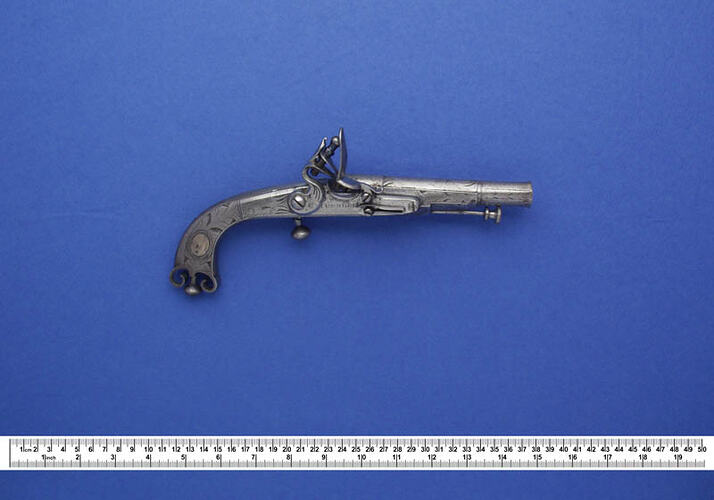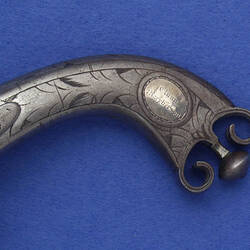Summary
Flintlock pistol, belt. All metal. Cal. 33 bore, (.520 in.) muzzle loading, smooth bore barrel 5 in. (127 mm.) long, slightly belled at muzzle. The steel butt with ramshorn finials was the classic Scottish Highland pistol in the eighteenth and nineteenth centuries.
Made by Thomas Murdoch, Leith, Scotland, circa 1770-1790.
This pistol once belonged to the head of the Macpherson clan, originally to Duncan Macpherson of Cluny (1748-1817), the 19th Chief of the clan, and then to his son Ewen Macpherson of Cluny (1804-1884). The pistol is therefore referred to by members of the clan as the "Cluny Pistol".
"Creag Dhubh", engraved on the pistol, was the war cry of Clan Macpherson.
The pistol was sold as part of a large sale of historic relics, pictures and books from the Estate of Albert Macpherson of Cluny, the last of the direct line of the Macphersons of Cluny. The collection was removed from Cluny Castle, Newtonmore, Inverness-shire, and an auction held in Glasgow by auctioneers Wylie & Lochhead on 3 May 1943. Four flintlock pistols by Murdoch, including this pistol, were sold in two lots.
In 1954 the pistol was for sale in Montreal, Canada, and purchased by Herb Glass, the curator at West Point Museum in Bullville, New York. It was then exchanged with the Museum of Applied Science in Melbourne (now Museums Victoria) in 1954.
The pistol is now on loan to the Clan Macpherson Museum in Newtonmore, Inverness-shire, Scotland.
Physical Description
Flintlock pistol manufactured in Scotland. All metal (steel) with an overall grey appearance with a dull sheen. Engraved decoration over all components. Side lock & hammer, ball trigger, steel butt with ramshorn finials, ball with vent pricker screws in butt between curls of ramshorn. Flat grip has monogram plate either side, steel ramrod with knob at tip, steel belt hook on L.H. side.
Significance
The pistol is of historical significance as an important surviving relic of Clan Macpherson from the eighteenth century, following the Jacobite rebellion, which resulted in the defeat of the Jacobite army at Culloden in 1745 and the forcing of many Jacobite leaders into exile. Ewan Macpherson of Cluny, the 18th chief of the clan, remained hidden on his estates for many years, until he escaped to France in 1755 and died the following year.
Duncan Macpherson of Cluny, the original owner of the pistol, had been born in a kiln used to dry corn in 1748, as his parents were in hiding on the Cluny estates. He was therefore later often called Duncan of the Kiln. Duncan and many of his Highland generation joined the British Army, and he would become a lieutenant-colonel of the 3rd Foot Guards. Subsequently his son Ewen would become a lieutenant-colonel of the Inverness Highland Rifles.
While offering loyalty to the United Kingdom, and becoming leaders in its volunteer regiments, the Clunys, like many other clan leaders, continued to celebrate highland customs and Jacobite traditions. The pistol and other Highland ceremonial dress was a significant part of expressing this distinctive political and cultural identity.
More Information
-
Collecting Areas
-
Acquisition Information
Exchange from Herb Glass - West Point Museum, May 1954
-
Maker
Thomas Murdoch, Leith, Lothian, Scotland, Great Britain, 1730-1785
-
Owner
-
Owner
-
Inscriptions
Engraved under lock: 'T.MURDOCH'. Engraved on small, oval, silver plates on either side of grip: 'Cluny Macpherson' on left side and 'CREAG DHUBH' on right side.
-
Classification
-
Category
-
Discipline
-
Type of item
-
Overall Dimensions
24.5 cm (Length), 4.6 cm (Width), 11.8 cm (Height), 443.1 g (Weight)
-
References
See file for ST 25294.
-
Keywords





